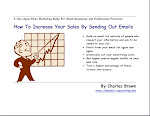The Before and After Scenario is one of the oldest, and best, methods used by freelance copywriters. And why not? It works because it paints a vivid portrait for your prospect of how he can realize a major change in his life.
A “Before-Scenario” depicts a person whose circumstances are much like that of your targeted prospect: overweight, broke, stuck in a dead-end job, bald or what have you. This is a person your targeted prospect can identify with because he or she languishes under the very same circumstances.
Then you present an “After-Scenario” depicting one of your satisfied customers who is delighted with the changes your product or service has brought about. She is now fit and trim (and has the requisite bathing suit pictures to prove it), they now have enough money to live the life they have always dreamed about, or he now has a full head of hair and is irresistible to the opposite sex.
The simple truth is that now matter how familiar we are with this kind of advertising, it still works because the targeted prospect identifies with your Before-Scenario and strongly wants to escape from those circumstances. And the After-Scenario offers the prospect the very life he or she wants to escape to.
But at times the very familiarity of this formula may simply get old in your market. Nevertheless, there are a few ways to get even more mileage out of this old advertising workhorse by adding a few twists:
- Create A “Virtual” After-Scenario Sometimes you may not want to use a real person’s situation, but want your reader to visualize his or her own Before and After Scenario.
You do this by injecting a lot of emotion into the problem your product or service is designed to solve.
Suppose your company provides auto financing for people with poor credit. You could create a Before-Scenario by vividly describing the embarrassment of driving an old, dilapidated car. Remind the prospect of the constant fear of driving a car that could break down on a remote highway late at night or on a busy highway in the middle of rush hour traffic. You could also, stir up the humiliation of being turned down for financing from traditional lenders.
Then you paint a second, emotional-filled scene of your prospect driving an attractive, dependable car, after being treated with dignity and respect by your finance officers. Paint an emotional picture of your prospect being seen by friends and neighbors driving this nice looking, late model car and having the peace of mind that the monthly payments are reasonable and that the car is in very good working order.
- Depict a Negative After Scenario. Sometimes you have to educate your prospect about why buying your competitors’ cheaper product is more costly in the long run. Here is an example, written by Dan Kennedy, to sell an ordinary product like shoes:
…but if you insist on just wearing any old pair of ordinary shoes, here’s what you have to look forward to in your so-called golden years; fallen arches…intense lower back pain…even pain from just walking around a shopping mall! You’ll be asking your friends to slow down so you can keep up. You’ll be futilely soaking your feet at night like some old fuddy-duddy. You may even need pain pills just to get to sleep.With a Negative After-Scenario, you are projecting an undesirable future resulting from your prospect’s shortsighted attempt to save a little money now by buying an inferior product, or by not spending any money at all to solve a known problem while there is still time.
- A Back-Story Scenario. This Before and After formula is not seen by your reader, but is sketched out for you the writer and marketer. Even if I am writing copy that follows a different format, I will often write out a before and after comparison for my own use when I begin my work. This enables me to clearly see the benefits the prospects are seeking in the form of specific changes they want to experience in their lives.
I want to know what the prospect is dissatisfied with now, and how intensely that dissatisfaction feels. I also want to know how the prospect wants to feel in the future and what changes must take place in order to achieve that desired state and the emotions that will come with it.
Let’s face it, I don’t want to overlook a single benefit that my readers might be seeking. And without my own draft version of a before-after sketch, I might miss the very benefit that will trigger the most response.
Every worthwhile product or service helps to bring about a desired change. And let’s face it, all of us, regardless of what we sell, are really in the business of selling change. A person who is satisfied with the status quo is not a prospect, and will never be a customer.
But when that person is ready for a change, and has become dissatisfied with the way things are right now, a strong Before and After Scenario can show them the way to find that change.
COPYRIGHT © 2006, Charles Brown
Labels: storytelling



0 comments:
Post a Comment